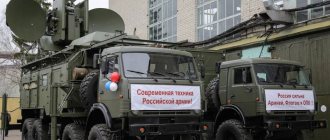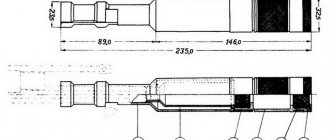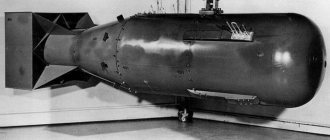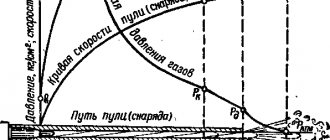| Ground-based powerful jamming system "Pelena-1". Designed to suppress the radar of AWACS aircraft. |
Analysis of armed conflicts of the late 20th – early 21st centuries. shows that electronic warfare ( EW, or in Western terminology, electronic warfare) is becoming one of the key elements of modern wars. Organizationally, electronic warfare is one of the components of information operations.
The essence of electronic warfare is to temporarily or permanently reduce the effectiveness of the use of enemy reconnaissance assets, weapons, and military equipment through electronic or fire suppression (destruction) of its electronic equipment, control systems, reconnaissance, and communications. Thus, electronic warfare can include both temporary disruption of the operation of enemy radio-electronic systems by jamming, and the complete destruction of these systems (fire damage or capture). Electronic warfare also includes measures for electronic defense (RED) of its information systems and electronic reconnaissance.
The saturation of the modern battlefield with information systems determines the extremely important role of electronic warfare in modern and future wars. The experience of recent military exercises has shown that even if one of the warring parties has an overwhelming superiority in high-precision weapons, it cannot be guaranteed to count on victory if its control structures are suppressed by electronic warfare.
The main targets during electronic warfare operations are:
- elements of troops and weapons control systems;
- reconnaissance means;
- systems for storing, processing and distributing information;
- radio-electronic means;
- automated systems, databases and computer networks;
- personnel involved in decision-making and management processes.
The increasing role of electronic warfare in modern wars is determined by two factors.
Firstly, the increase in the scale and depth of operations, the saturation of troops with modern means of automation, control and reconnaissance led to a sharp increase in the share of supporting forces in operations. According to Western experts, in modern combat operations about 2/3 of all forces perform reconnaissance, command and control, electronic warfare, support, etc. tasks.
Secondly, the increase in the capabilities of electronic warfare forces and means to influence enemy combat control systems. Modern electronic warfare systems are very versatile: they can be used to the depth of both a separate combat operation and the entire theater of war, at any time of the day, use lethal and non-lethal weapons, operate as part of various multi-purpose integrated systems (combat control, communications, computer intelligence support , fire destruction, combating enemy combat control systems), provide comprehensive protection of their control systems and even use enemy computer networks to their advantage.
Nowadays, further improvement of technical means and methods of electronic warfare is taking place very quickly. First of all, this applies to the armed forces of the United States and Great Britain. The armed forces of these countries and the NATO Allied Forces have well developed the methodology of simultaneous or phased strikes against the enemy using fire weapons, electronic warfare, strategic and tactical camouflage, disinformation and psychological warfare.
History of creation
The complex was developed at the Gradient Research Institute in Rostov-on-Don. The creation and testing of the first samples took place at the Kvant research and production enterprise in Novgorod. Now serial production of the machine is carried out by BEMZ JSC (electromechanical plant in Bryansk).
The design of the Krasukha 4 electronic warfare module began back in the 90s of the last century, when a government contract was concluded and tactical and technical specifications were issued. The customer is the electronic warfare of the Strategic Missile Forces (missile forces). At the same time, “Krasukha 2” was created. The versions differ in equipment: the “four” uses digital, the “two” uses analog.
In addition, “Krasukha 4” is installed on a 4-axle KamAZ chassis, and “Krasukha 2” is installed on a BAZ-6910-022 chassis. By 2014, 10 ground-based Krasukha 4 complexes were produced.
Historical reference
Port Arthur, April 15, 1904. The Japanese cruisers Nissin and Kasuga, having taken up positions beyond the range of Russian shots from the fortress, corrected the fire of the battleships located in another bay and conducting cross-fire.
Using radio transmitters on the battleship Pobeda and Zolotaya Gora, they interfered with enemy warships, which fired more than 60 shells to no avail—they did not hit the Russian ships.
After this incident, during the Russian-Japanese confrontation, the use of radio interference was used many times, including not only the suppression of enemy communications, but also their interception and subsequent decryption. According to tradition, the date of birth of the radio warfare troops would have to be December 16, 1942.
On this day I.V. Stalin signed Resolution of the State Defense Committee No. GOKO 2633 ss “On the organization of a department for managing the operation of jamming radio stations within the Military Intelligence Directorate of the General Staff of the Red Army.” But they accepted it precisely on April 15 in connection with the first use, by the way, of foreign-made jamming equipment (Russia did not yet have its own at that time) in Port Arthur.
Now Russian electronic warfare systems are the most modern military and electronic Russian technologies. And in 1999, April 15 was declared Electronic Warfare Specialist Day.
DEVELOPMENT OF EW IN THE RUSSIAN ARMED FORCES
Electronic warfare has a long history in Russia. For the first time, the suppression of enemy radio networks by interference to disrupt the coordination of artillery fire was successfully used by Russian signalmen back in 1904. Also during World War I, Russian radio communications were used to interfere with German radio networks.
During the Great Patriotic War, electronic warfare was carried out on an ongoing basis. On December 16, 1942, the State Defense Committee of the USSR issued a decree “On the organization in the Red Army of a special service to jam German radio stations operating on the battlefield.” In pursuance of this resolution, Chief of the General Staff, Deputy People's Commissar of Defense of the USSR A.M. The next day, Vasilevsky issued a directive “On the formation of a special group and special radio interference divisions.” A special term is introduced - “RPD” (electronic suppression).
After the war, there was a rapid improvement in radio communications, radar and on-board radars of aircraft and ships, and the creation of missiles with radar homing heads. At the same time, the need arose to both reduce the effectiveness of the use of enemy weapons and electronic systems, and to protect one’s own radio networks and electronic systems from suppression. For this 1950s. Special electronic warfare equipment is being developed and supplied to the troops: radio interference transmitters, dipole and corner reflectors. For the purpose of qualified use of electronic warfare equipment in the Soviet army, during the same period, a special electronic warfare service was created.
Subsequently, to equip electronic warfare units, protect aircraft, helicopters, ships, tanks and other military equipment, automated electronic warfare systems began to be created, including reconnaissance equipment, jamming in various wave ranges, and equipment for analysis, information processing and control.
In 1962, the term “BRESP” (fighting with electronic means of suppression) was introduced, and the electronic warfare service began to be designated by the same term. Among the tasks of the BRESP service were nuclear and fire destruction, electronic suppression and capture of enemy electronic objects (command posts, communication centers, radars, etc.). At the same time, there was a certain discrepancy between the tasks and capabilities of the BRESP units: they only had the means of jamming, but not the means of engaging fire and capturing enemy targets. These tasks were the responsibility of the operational departments of the headquarters.
Since the early 1960s. new powerful means of fire destruction of radio-electronic objects have appeared - missiles aimed at radio emission. In 1963, the air-to-air missile Shrike entered service with the US Armed Forces. In the USSR, similar types of weapons are being created: in 1965, the KSR-11 missile entered service with the Soviet Long-Range Aviation, in 1968 - the Kh-22P, and in 1972, front-line aviation received the Kh-28P missile. The adoption of these missiles was very important for the reason that Soviet aircraft jamming stations were significantly inferior to American ones in power, frequency range and speed, and fire damage to enemy radars could compensate for this deficiency.
In 1969, the term “electronic warfare” was introduced, which is used in the Russian Armed Forces to this day. Accordingly, the BRESP bodies were transformed into an electronic warfare service, which, in addition to electronic warfare functions, was also assigned the task of ensuring electromagnetic compatibility of radio-electronic systems in order to ensure sustainable control of troops and weapons. True, in 1976, instead of electronic warfare, the term EPD (“electronic suppression”) was introduced, but it did not catch on, and in 1977 it was again replaced by electronic warfare.
In order to conduct research and train qualified personnel in the field of electronic warfare, an extensive network of research centers and educational institutions was created in the USSR. In 1960, the leading institute for electronic warfare was created - 21 NIITs (now 5 Central Research Institutes). Specialized departments and laboratories were created in research institutes, training grounds and in centers for the combat use of weapons and military equipment of branches of the Armed Forces. In the interests of electronic warfare, specialists from such institutions as the 30th Central Research Institute of the Ministry of Defense, the State Research Institute of the Air Force, the 4th TsBP and PLS of front-line aviation, the 43th TsBP of Long-Range Aviation, the Air Force Engineering Academy named after. N.E. Zhukovsky.
In 1980, the Voronezh Higher Military Engineering School of Radio Electronics (later the Voronezh Military Institute of Radio Electronics - VIRE) was created, training qualified technical specialists in the field of electronic warfare. A number of military universities were also created that trained specialists in the field of electronic warfare in Kyiv, Kharkov, Minsk, Riga, etc., but after the collapse of the USSR their potential was lost for Russia. In fact, VIRE remained the only specialized Russian military university that produces electronic warfare specialists for the army. However, in 2006, for unknown reasons, this educational institution was annexed as an electronic warfare department to the Voronezh Military Aviation University.
Training of junior electronic warfare specialists for all types and branches of the military, reserve officers, as well as foreign cadets is carried out at the Tambov Interspecific Training Center (TMTC), established in 1962.
Soviet electronic warfare specialists gained practical experience during the wars in Korea, the Middle East and Afghanistan.
During the first Chechen campaign, the fighting in Dagestan and the subsequent counter-terrorism operation on the territory of the Chechen Republic, Russian electronic warfare units took an active part in the hostilities.
INVFs on the territory of Chechnya created an extensive control and communication system, including cellular, trunk, radio relay, short-wave and ultra-short wave, cable and satellite communications. The tasks of the Russian electronic warfare units were to open and suppress the communication systems of illegal armed groups, as well as to collect information through radio reconnaissance about the number and location of militant detachments, the plans of the Chechen command, etc.
The actions of the electronic warfare forces produced good results. Often, during radio conversations, militants themselves indicated the location of their bases, concentrations of manpower, etc. These data were immediately implemented by Russian troops in the form of artillery and air strikes on the indicated places. That's just one episode.
03/20/1995. From radio intercepts of negotiations between Chechen commanders:
"- Where are you?
- We are coming to you.
“Tell the guys to drive through the Mesker-Yurt intersection and come to us.”
Artillery strikes were carried out on a concentration of militants and equipment in the area of the indicated intersection, as a result of which 2 armored personnel carriers and two vehicles with militants were destroyed.
During the assault on Grozny in the period from December 10 to 20, 1999, electronic warfare units, only through radio reconnaissance, completely revealed the defense system and the number of enemy forces defending the southeast of the city. With such actions, electronic warfare specialists greatly facilitated the conduct of operations by strike units and helped save many lives of Russian soldiers. Being under constant pressure from electronic warfare, the detachments of Chechen militants gradually lost control and coordination of actions, which played an important role in the outcome of hostilities on the territory of the Chechen Republic.
Mobile automated air defense electronic warfare system. Completely eliminates the possibility of launching a targeted missile or bomb strike on a protected object. |
During the “five-day war” with Georgia, Russian electronic warfare forces also acted quite successfully. According to the Latvian military expert, reserve brigadier general Karlis Krustinles: “Georgia has problems both with air defense and with the interconnection of units. There were situations when combat units communicated with each other with the help of messengers, because any communication ceased to function. The Russian army prepared in advance to suppress not only radio-electronic communications and radars, but also ordinary telephone communications.”
There was also counteraction to electronic reconnaissance conducted from NATO ships in the Black Sea.
In the “five-day war” it became obvious that the issue of advantage in an air war is largely a matter of electronic warfare. As it turned out, in the first days of the war, electronic warfare in the Russian group was not very well established. The radio and electronic intelligence forces of the Russian Air Force were transferred to the subordination of the GRU General Staff. However, the latter provided practically no assistance to the air forces, as a result of which they did not have reliable information about the location. The aircraft participating in hostilities did not fully meet the requirements for electronic protection against air defense systems. All this led to aviation losses from anti-aircraft fire, including the most painful - the Tu-22M3 long-range bomber.
After the shock of the first losses, representatives of the Air Force High Command intervened and developed recommendations for the crews of airplanes and helicopters participating in combat missions. A significant place in them was devoted to electronic defense measures. In particular, do not use aircraft in combat that do not have individual electronic warfare equipment, exit from an attack with Su-25 aircraft during a massive shooting of thermal traps, use attack aircraft only under the cover of group means of protection by electronic warfare aircraft and helicopters. After this, aviation losses stopped. However, according to experts, the Russian Air Force has serious gaps in the field of electronic warfare, both in terms of personnel training and technical equipment, and in a collision with a truly strong air defense, losses would be many times higher.
In 2009, electronic warfare units and subunits were transformed into a separate type of troops of the Armed Forces of the Russian Federation, including electronic warfare formations, units and subunits within the operational-strategic commands.
According to the former commander of the electronic warfare forces O. Ivanov, today the effect of electronic warfare means is becoming comparable to the use of modern high-precision weapons, and in some respects even surpasses it. At the same time, Russian electronic warfare systems are not inferior to their foreign counterparts. In addition to modernizing existing ones, new multifunctional complexes are being created, some of which can be considered technological breakthroughs. According to O. Ivanov, great opportunities are now opening up for electronic warfare. True, he himself, strangely enough, in July 2011 voluntarily resigned from the post of commander of the electronic warfare forces at the age of 45, when, it would seem, great prospects were opening up for successful career and professional growth. According to some experts, among the reasons for the resignation is disagreement with the provisions of the military reform being carried out in Russia, in particular, with the introduction of the new electronic automated command and control system for troops ESU TZ, which the military criticizes for numerous shortcomings inherent in the technical specifications.
What is electronic warfare
Electronic warfare is electronic warfare, one might say armed warfare, based on the use of radio emission for radio-electronic destruction (suppression) of the operation of radio-electronic devices of technical systems for command and control of troops, weapons, communications, reconnaissance of the enemy to protect the radio-electronic equipment of their own control systems.
Americans use several terms to refer to electronic warfare:
- Electronic Warfare or EW - electronic warfare;
- Command, Control, Communication Countermeasure or С3СМ - counteraction to control;
- Electronic Combat - electronic warfare.
Electronic warfare objectives:
- disruption of the functioning of enemy army and weapon control systems;
- reduction in the effectiveness of the enemy’s use of weapons, military equipment, and electronic equipment;
- protection of weapons, equipment, and significant objects from enemy reconnaissance devices;
- protection of technical means of controlling your troops and weapons.
The actions of the army's electronic warfare units are coordinated with the maneuvers of combat aviation, air defense and artillery.
As for the design, application possibilities and technical characteristics of the ground-based radio-electronic suppression module RB-271A “Krasukha-4” (index 1RL257), the information is classified for known reasons.
Modern electronic warfare systems for the Russian army
The Rtut-BM electronic reconnaissance and defense station was developed by the Radioelectronic Technologies Concern (KRET), part of Rostec and one of the domestic leaders in this field. In addition, the Concern supplies, as part of the state defense order, the Moscow-1 radio-electronic reconnaissance station, the Rychag-AV helicopter-based radio-electronic reconnaissance and active jamming system, electronic warfare systems of the Vitebsk family for military transport aviation, radio-electronic reconnaissance and suppression stations. Krasukha." Key competencies in electronic warfare within the State Corporation are also concentrated by the Sozvezdie Concern, which is part of the Ruselectronics holding. Thus, Rostec produces solutions in the field of electronic warfare in all environments and for all types of media.
Enterprises of the State Corporation supply the Russian army with specialized helicopters – jammers Mi-8MTPR-1 with electronic warfare systems “Lychag-AV”, which are capable of completely “blinding” the enemy within a radius of several hundred kilometers. Another of the modern airborne defense systems is Vitebsk. They are equipped with Su-25SM attack aircraft, and some parts of the complex are installed on board Ka-52 and Mi-28 combat helicopters.
Mi-8MTPR-1 helicopter with the Rychag-AV electronic warfare system
The “brain center” of electronic defense on the ground can be called the Moscow-1 reconnaissance and control complex. Its capabilities allow for electronic reconnaissance of airspace at a range of up to 400 km. At the same time, Moskva-1 operates in passive mode, which ensures high secrecy and the ability to remain invisible to enemy detection means. Moskva-1 can simultaneously control more than seven electronic warfare systems.
For example, Moskva-1 is capable of controlling mobile electronic warfare systems of the Krasukha family, which at a range of up to 300 km detect and effectively suppress on-board radars of enemy aircraft. “Krasukha” also makes it possible to suppress all radar systems installed on manned and unmanned aircraft, cruise missiles and reconnaissance aircraft.
Electronic reconnaissance and control complex "Moscow-1"
Another unique ground-based electronic warfare system is Infauna. It includes not only traditional means of electronic suppression of communications and control equipment, but also means of optical-electronic reconnaissance and suppression. The multifunctional "Infauna" provides radio reconnaissance and suppression of radio-controlled mine-explosive devices, protects personnel and equipment. The complex is equipped with an aerosol countermeasures function, which significantly reduces the effectiveness of the use of enemy high-precision weapons with video and laser guidance systems.
The device of the radio-electronic complex
The Krasukha 4 electronic warfare complex consists of 2 1RL257 vehicles equipped with radio-electronic devices and antennas, including cutting-edge digital technology, an antenna unit on a sliding stay, and parabolic antennas that are capable of transmitting a signal in azimuth and elevation without restrictions.
- chassis KAMAZ-6350 and KAMAZ-6350-334;
- container body (probably for installation on the KAMAZ-6350-334 chassis);
- ultra-frequency microwave equipment U52219 based on a traveling wave lamp;
- wide-range antenna with mast R-168 SHDAM (range from 30 to 108 MHz);
- telescopic mast device;
- radio station R-168-5 and radio station R-168-100;
- graphic information manipulator;
- modules KLVS-08 (ship local area network), LAN (local area network), CPU-11 modules;
- device for recording and transferring information UZPI - micro-computer with built-in storage;
- COMPUTER Baget-23V, COMPUTER "BAGET-RS3BM" - secure computers used in military equipment;
- satellite navigation system BRIZ-KM;
- data transmission equipment;
- automated leveling system;
- diesel electric units ADS10 – diesel power plants, autonomous sources of electricity;
- oscilloscope and other instruments.
After the module’s electronics analyze the signal parameters coming from the enemy’s equipment, the enemy’s radar is “attacked” by intense interference.
And as a result: the combat equipment of the opposing side is deprived of the ability to detect targets and direct high-precision weapons at them.
Performance characteristics
The operating frequency range is from 8000 to 18000 MHz.
Energy potential – from 50 to 64 dB.
Action sector: azimuth – 360°, elevation – from -1° to + 60° (+85°)
Capacity - 1 radar of a spacecraft and 1 aircraft of the combat control and target designation system E-8 JSTARS or 11 radars of tactical aircraft.
Radius of the coverage zone when suppressing radar:
- attack aircraft of tactical aviation - 11 - 19 km,
- reconnaissance and strike modules – 16 – 41 km,
- spacecraft – 15 – 25 km.
Coagulation and deployment time: in summer – 20 minutes, in winter – 40 minutes.
The preparation time for work, not taking into account deployment/collapse, is 3 minutes.
Continuous operation time – 24 hours.
Power consumption – 30 kW.
Application
The Krasukha 4 station is designed to suppress the following devices on aircraft, helicopters, unmanned aerial vehicles, and spacecraft:
- radar stations for surveying the surface of the earth;
- Radar of reconnaissance and strike complexes;
- Surface-to-air and air-to-air weapon control radar;
- multifunctional radars.
As mentioned above, the radio-electronic “filling” of the ground module detects the source of signals from enemy military equipment, determines their parameters and is exposed to interference radiation. The electronic warfare system is capable of suppressing the operation of aircraft with long-range radar surveillance of the AWACS type, and space equipment in missile guidance systems.
In addition, the system is capable of covering stationary objects from the radar of E-8 JSTARS reconnaissance aircraft, radar of attack aircraft, etc.
The wideband active jamming module copes with a wide variety of modern radars, while it not only jams signals, but also falsifies, distorts them, creates false targets and thus manipulates the radio channels of drones and missiles fired by the enemy.
One of the probable situations: the rocket flies at an altitude of 200 m, “Krasukha 4” creates radiation that affects its electronics. And it receives false data that it is at an altitude, for example, 1000 m. Having received such information, the rocket, according to the program laid down for it, begins to descend to the required altitude... The result is obvious.
Another clear illustration of the capabilities of the Krasukha 4 radio-electronic module: AWACS combat systems (aircraft + AEW long-range radar detection and control system, the same AWACS) lose the ability to recognize “friends” and “foes”, as well as to conduct control, which could end with an attack on one’s own targets and the release of a high-precision projectile into the “emptiness.”
How it works: on the ground and in the air
Among other main directions in the evolution of electronic warfare systems is the rapid development of air- and sea-based electronic warfare systems and means. Today, electronic warfare systems can be placed on a wide variety of military equipment. Ground-based electronic warfare systems can be installed on tanks or vehicles, such as KAMAZ vehicles. Multi-ton tractors are equipped with heavy-duty electronic warfare systems that have enormous ranges.
Electronic warfare equipment is also installed on board helicopters. Externally, such a helicopter is no different from a regular one. And only by looking inside, you can understand that this machine is special, having a special electronic filling. It forms a kind of radio-electronic dome around the helicopter: upon approach, the missile simply changes direction and goes to the side.
Ground-based electronic warfare systems operate on the same principle, creating an invisible shield around the equipment. Let's look at the example of the modern Russian complex "Rtut-BM". The last two letters in the name mean that it is located on a combat vehicle. This could be a car, an armored personnel carrier or an MTLB armored artillery tractor.
Complex "Mercury-BM"
A vehicle with the Mercury complex is installed in a place where an enemy artillery and missile strike is likely. At the moment of an artillery attack, the system’s electronics almost instantly determines the operating frequency of the enemy radio fuse. "Mercury" creates a signal that affects the radio fuse, and it goes off ahead of time. The shells explode at a safe height of 200-300 meters. During operation, one Rtut-BM station can protect both itself and manpower, equipment and facilities on an area of up to 50 hectares.
Modifications
The predecessor of “Krasukha 4”, capable of “attacking” only one target at a time, is considered to be the SNP-4 station, which can simultaneously affect 6 – 8 targets. But the radio interference range of the Krasukha is 3 times greater than the capabilities of the SNP-4.
The Krasukha 2 electronic warfare system with analogue equipment was created for electronic warfare against airborne early warning and control radars "AWACS", as well as covering command posts, troops, air defense systems, etc. Crew - 7 or 3 specialists + additional equipment. On board the radio-electronic module there is an air conditioner and a heater. Maximum speed – 80 km/h.
"Krasukha-2" is equipped with the latest software, operating on new interaction, search and suppression algorithms. The software provides the ability to quickly adjust the list of radar signal images that are stored in the system memory. In addition, the Krasukha-2O has the function of detecting enemy objects and targeting them with high-precision weapons.
One of the main tasks of the Krasukha-S4 system is to provide protection from radar reconnaissance of ground objects by electronically suppressing radar stations of aircraft and space equipment.
Crew (composition): head of the complex, two operators, two electrician drivers. The range reaches 300 km, and the vehicle also has the ability to detect a target located at an altitude of 10 m and above.
GOALS, OBJECTIVES AND MEANS OF EW
Carrier-based electronic warfare aircraft EA-18G Growler |
The goals for electronic warfare in modern warfare are not only to disorganize the enemy’s combat control systems, but also to deprive him of the ability to use information about the combat situation, ensure that the enemy is ahead of the enemy in making combat decisions, and reduce their losses during combat operations.
In accordance with the views of the American command, the main element of electronic warfare is an electronic attack using ground- and air-based electronic warfare systems, as well as portable ones and those thrown behind enemy lines.
Electronic attack means are conventionally divided into two types: non-destructive and destructive.
Non-destructive means of electronic jamming, electronic disinformation, infrared countermeasures (false thermal targets and stationary generators of pulsating infrared interference, designed to combat air-to-air and ground-to-air missiles equipped with infrared homing heads). The tasks of these means are: suppression or disabling of radio-electronic or optical-electronic systems, reconnaissance, communications, and navigation equipment; imitation of the operation of radio-electronic systems in order to mislead the enemy; overload of enemy communications systems; impact on its personnel servicing radio-electronic systems or participating in command and control processes.
Destructive weapons are directed energy weapons (electromagnetic weapons), precision weapons and ammunition with radio-electronic radiation homing heads.
Directed energy weapons are worth looking at in a little more detail. These systems are also called magnetrons, and in Western terminology – active electronically scanned array (AESA). This weapon affects the electronic systems of enemy equipment with microwave waves, disabling them. With its help, you can completely turn off the on-board electronics of an aircraft, stop the engine of a car or ship, etc. When exposed to a large area, this weapon can act as non-destructive.
| Directed energy weapon based on the Hemvee |
Directed energy weapons entered service with the US Armed Forces relatively recently. The latest American aircraft are equipped with it: the F-35 (however, its electromagnetic weapons are of a defensive nature and are intended to disable enemy missiles) and the Boeing EA-18G Growler carrier-based electronic warfare aircraft. The latter can carry five suspended containers with electronic warfare weapons, including AESA equipment. The EA-18G was successfully used to suppress Libyan air defenses in 2011. There are plans to install directed energy emitters on ships and ground combat vehicles. Prototypes of non-lethal directed energy weapons have also been created, designed to impact a person (dispersing a crowd, etc.).
Speaking about directed energy weapons, we should also mention the US testing of laser weapons to combat ballistic missiles, but at the end of 2011 this program was closed.
The tasks of destructive electronic attack means are: suppression, defeat, destruction of enemy reconnaissance, navigation, control systems, electronic systems of military equipment and weapons; defeat of enemy personnel involved in servicing these systems.
An important element of electronic warfare is electronic protection of friendly troops. It includes three areas:
- direct protection of radio-electronic systems (protection from enemy interference, atmospheric interference, weapons targeting radio emissions, directed energy means, electronic disinformation);
- ensuring electromagnetic compatibility at control points and in combat formations of troops (protection of radio-electronic systems of friendly troops from mutual interference, including from electronic attack means used against enemy electronic systems);
- electronic defense during information operations (protection of information circulating in combat control systems, information protection of reconnaissance assets, electronic attack and electronic defense).
In the interests of electronic defense, comprehensive technical control is carried out. Its task is to control the enemy’s ability to collect intelligence information from radio-electronic systems.
Comprehensive technical control includes:
- radio control - control over information circulating in their radio networks;
- radio engineering control - monitoring the enemy’s ability to collect information about the technical parameters of their electronic distribution systems;
- radar control - control to ensure that the power, nature, direction and types of emissions of one's own electronic zones do not exceed strictly established standards in order to make it difficult for the enemy to collect information about them (electronic camouflage);
- electro-optical control - control over the possibility of the enemy obtaining information using television cameras, receiving thermal radiation;
- acoustic and hydroacoustic control - monitoring the possibility of the enemy receiving information by receiving sound signals propagating in the air and water.
Programming and reprogramming of electronic warfare equipment during a combat operation, although not a component of electronic warfare, directly affects its effectiveness. Their tasks are: ensuring timely targeting of electronic warfare equipment to priority targets; restructuring of electronic warfare equipment in connection with the requirements of the situation; achieving the highest efficiency of their use in terms of power, direction, type of electronic attack (defense) when the object of attack (defense) changes the parameters of electromagnetic radiation and performs a maneuver; reservation and timely replacement of electronic warfare equipment when they fail.
Interesting Facts
In 2015, the Krasukha-4 ground module was used in combat conditions in Syria. A significant number of American Tomahawk missiles were diverted from their targets. During the exercises, in which, in addition to the Krasukha, Su-24 and Su-34 participated, the aircraft were unable to complete their missions, “blinded” by the radio influence of the ground-based electronic warfare system.
In conclusion, it is worth talking about the opinion of Western experts about “Krasukha 4”: experts emphasized that there are no analogues of such equipment in the United States. Domestic experts also highly appreciated the capabilities of the ground module and other modern Russian electronic suppression systems. They calculated that such equipment makes it possible to increase the combat potential of the ground forces by a factor of two, reduce aviation losses by a factor of six, and naval losses by a factor of three.










